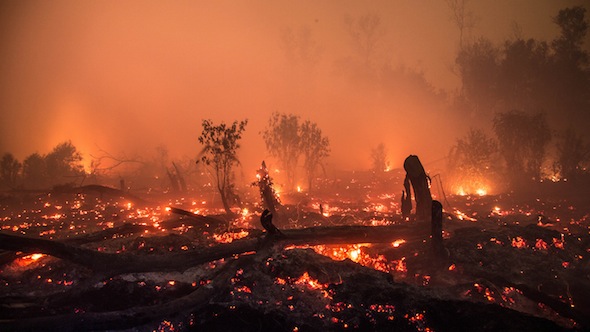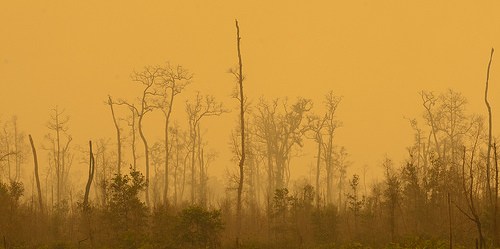Peat is partially decayed, dead vegetation that has accumulated over thousands of years. Though peatlands are generally saturated with water and difficult to set ablaze, they can become tinderboxes when they are drained to make way for agricultural plantations like pulp and paper and palm oil.
When peatlands burn, huge amounts of CO2 are released.
Although peatlands cover just 3-5 percent of the Earth’s surface, they store more than 30 percent of all soil carbon. And while the area of peatland currently classified as drained and degrading covers less than 0.4 percent of the global land surface, it is responsible for 5 percent of global anthropogenic emissions, according to the United Nations Environment Programme (UNEP).
INDONESIA’S PEAT PROBLEM
Fires in forests and former forestlands occur in Indonesia in the dry season every year – particularly in the provinces of Riau and Jambi on the island of Sumatra, and West Kalimantan and Central Kalimantan on the island of Borneo.
However, the haze that spreads to other countries is no longer restricted to drought years, and has become increasingly frequent due to ongoing deforestation of peatlands in Indonesia.
The 2015 forest fires in Indonesia were devastating for the environment, resulting in 884 million tons of carbon dioxide being released in the region – with 97 percent originating from burning in Indonesia. The corresponding carbon emissions were 289 million tons, with 1.2 billion tons of associated carbon dioxide-equivalent emissions.
The gravity of this environmental crisis motivated Indonesia’s President Joko Widodo to pledge to restore two million hectares of the country’s degraded peatlands by 2020 to prevent future fires.
A NEW GLOBAL PEAT INITIATIVE
Policymakers at COP22 are now looking more closely at how peatlands can be better managed in order to curb carbon emissions. While the launch of the peatland hotspots map at COP21 in Paris last year marked the start of work to develop an online Global Peatland Atlas, more work needs to be done.
For one, there is a need for better mapping before restoration and conservation can begin in some areas. Additionally, new partners will need to be mobilized to make real progress towards sustainable peatland management. In an effort to achieve this goal, the United Nations Environment Programme (UNEP) is set to unveil its new initiative at the Global Landscapes Forum on 16 November in Marrakesh, Morocco.
The Global Peatlands Initiative aims to increase the conservation, restoration and sustainable management of peatlands in countries with significant peat deposits delivering benefits for agriculture, biodiversity and the climate. In terms of scale and scope, the initiative goes beyond any recent collaborative efforts on peat.
Among its founding members are: the governments of Indonesia, Peru and the Republic of Congo, UNEP, FAO, IFAD, the EC, Wetlands International, UNEP-WCMC, GRID-Arendal, Ramsar Secretariat, European Space Agency, WRI, Greifswald Mire Centre and SarVision/Sateligence.
We want you to share Forests News content, which is licensed under Creative Commons Attribution-NonCommercial-ShareAlike 4.0 International (CC BY-NC-SA 4.0). This means you are free to redistribute our material for non-commercial purposes. All we ask is that you give Forests News appropriate credit and link to the original Forests News content, indicate if changes were made, and distribute your contributions under the same Creative Commons license. You must notify Forests News if you repost, reprint or reuse our materials by contacting forestsnews@cifor-icraf.org.

